When there is a conflict between two published lists of requirements, such as Boy Scout Requirements (BSA Publication No. 33216) and a Merit Badge Pamphlet or the Boy Scout Handbook, the requirements book should be considered to be the controlling document, until a newer edition of Boy Scout Requirements is issued.
A new edition of Boy Scout Requirements ( #33216 - SKU#34765) was released in mid January, 2012. The new Boy Scout Requirements booklet has a minor change to Second Class rank requirement 5, plus minor changes to Star requirements 1 and 4, minor changes to Life requirements 1, 4, and 6, and a change to Eagle requirement 5 (which are NOT noted in the list on the inside front cover), a major revision to Woodwork merit badge, and minor changes to 13 other merit badges (including Athletics which is NOT noted in the list on the inside front cover), the requirements for the 2 new merit badges which were released in 2011, and the requirements for the new Welding merit badge being introduced early in 2012.
In late 2011, BSA released a new Guide to Advancement, BSA Publication 33088 (SKU 614448), which replaced the former publication 33088 entitled Advancement Committee Policies and Procedures. The Guide to Advancement is the official Boy Scouts of America source on advancement procedures.
BSA issued new editions of ALL of the merit badge pamphlets on August 1, 2008. The primary change to most of the pamphlets was the introduction of color photographs and diagrams, and new covers. The actual text and requirements, in most cases did not change from the previous editions. In some cases, however, the new editions do contain new information, and new requirements. If the copyright date in the new pamphlet is not 2008 or later, the text in the pamphlet, including the requirements, did not change, only the cover and illustrations. In addition, two of the old pamphlets, for the Architecture and Landscape Architecture Merit Badges were combined into a single pamphlet, although the Merit Badges remain separate and distinct from each other. Also, one Merit Badge, Auto Mechanics, was renamed to Automotive Maintenance, (and the emblem on the badge was changed). Although a new edition of the Lifesaving merit badge pamphlet was issued, the requirements did not change. However, the footnote relative to alternative requirements for the Second Class and First Class rank swimming requirements was deleted.
The new Robotics Badge, Pamphlet, and Kits were formally rolled out on April 12, 2011.
The new Chess Badge and Pamphlet was formally rolled out on September 7 2011.
The new Welding badge and pamphlet was released by BSA, and Scouts could begin earning the badge on February 24, 2012.
The new Kayaking badge and pamphlet was released by BSA, and Scouts could begin earning the badge on June 13, 2012.
The new Search and Rescue badge and pamphlet was released by BSA, and Scouts could begin earning the badge on August 20 2012.
New Definitions in the Guide to Advancement
Active Participation
Demonstrate Scout Spirit
Serve Actively ... in ... Positions of Responsibility
RANK CHANGES
Second Class
Star
Life
Eagle
NEW Merit Badges
Chess
Kayaking
Robotics
Search and Rescue
Welding
REVISED Merit Badges
Archery
Astronomy
Athletics
Bugling
Camping
Climbing
Fly Fishing
Graphic Arts
Hiking
Motorboating
Music
Personal Fitness
Scouting Heritage
Woodwork
Active Participation
The requirements for Star, Life, Eagle, and Eagle Palms all include a requirement to "Be active in your troop and patrol ..." The Guide to Advancement now contains an extensive section on how to determine whether the Scout has met the requirement. Rather than duplicate that information here, please click on the link to see the information.
Demonstrate Scout Spirit
The requirements for Tenderfoot, Second Class, First Class, Star, Life, and Eagle Palms all include a clause to "Be active in your troop and patrol ...", and the requirements for Eagle contain a similar clause, "Demonstrate that you live by the principles of the Scout Oath and Law ...." The Guide to Advancement now also contains an section on how to determine whether the Scout has met this requirement, too. Rather than duplicate that information here, please click on the link to see the information.
Serve Actively ... in ... Positions of Responsibility
The requirements for Star, Life, and Eagle all include a requirement to "Serve Actively ... in ... Positions of Responsibility" The Guide to Advancement now contains an extensive section on how to determine whether the Scout has met this requirement as well. Rather than duplicate that information here, please click on the link to see the information.
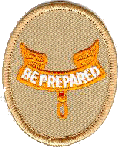 Second
Class
Second
Class
A minor wording change was made to requirement 5. The new wording reads as follows:
- Participate in an approved (minimum of one hour) service project(s).
 Star
Star
Minor wording changes were made to requirements 1 and 4. The new wording reads as follows:
- Be active in your troop and patrol unit (and patrol if you are in one) for at least four months as a First Class Scout.
- While a First Class Scout, take part in service projects project(s) totaling at least 6 hours of work. These projects must be approved by your Scoutmaster.
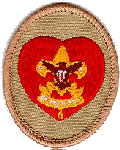 Life
Life
Minor wording changes were made to requirements 1, 4, and 6. The new wording reads as follows:
- Be active in your troop and patrol unit (and patrol if you are in one) for at least six months as a Star Scout.
- While a Star Scout, take part in service projects project(s) totaling at least 6 hours of work. These projects project(s) must be approved by your Scoutmaster.
- While a Star Scout, use the EDGE method to teach a younger another Scout (preferably younger than you) the skills from ONE of the following seven choices, so that he is prepared to pass those requirements to his unit leader's satisfaction.
- Second Class - 7a and 7c (first aid)
- Second Class - 1a (outdoor skills)
- Second Class - 3c, 3d, 3e, and 3f (cooking/camping)
- First Class - 8a, 8b, 8c, and 8d (first aid)
- First Class - 1, 7a, and 7b (outdoor skills)
- First Class - 4a, 4b, and 4d (cooking/camping)
- Three requirements from one of the Eagle-required merit badges, as approved by your unit leader.
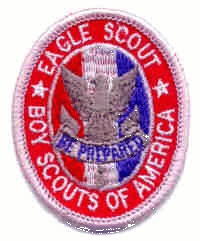 Eagle
Eagle
BSA revised requirement 5 (the Service Project requirement) as a result of the new Guide to Advancement 2011 (33088 - SKU 614448) and the new Eagle Scout Service Project Workbook (512-927 - 2011 printing), as follows:
- While a Life Scout, plan, develop, and give leadership to others in a service project helpful to any religious institution, any school, or your community. (The project should must. benefit an organization other than Boy Scouting.) The A project plan proposal must be approved by the organization benefiting from the effort, your Scoutmaster unit leader and troop unit committee, and the council or district before you start. You must use the Eagle Scout Leadership Service Project Workbook, BSA publication No. 512-927, in meeting this requirement. To learn more about the Eagle Scout service project, see the Guide to Advancement topics 9.0.2.0 through 9.0.2.15.)
 Chess
Chess
The requirements, badge, and pamphlet for this new badge was released by BSA on September 7, 2011.
- Discuss with your merit badge counselor the history of the game of chess. Explain why it is considered a game of planning and strategy.
- Discuss with your merit badge counselor the following:
- The benefits of playing chess, including developing critical thinking skills, concentration skills, and decision-making skills, and how these skills can help you in other areas of your life
- Sportsmanship and chess etiquette
- Demonstrate to your counselor that you know each of the following. Then, using Scouting's Teaching EDGE, teach the following to a Scout who does not know how to play chess:
- The name of each chess piece
- How to set up a chessboard
- How each chess piece moves, including castling and en passant captures
- Do the following:
- Demonstrate scorekeeping using the algebraic system of chess notation.
- Discuss the differences between the opening, the middle game, and the endgame.
- Explain four opening principles.
- Explain the four rules for castling.
- On a chessboard, demonstrate a "scholar's mate" and a "fool's mate."
- Demonstrate on a chessboard four ways a chess game can end in a draw.
- Do the following:
- Explain four of the following elements of chess strategy: exploiting weaknesses, force, king safety, pawn structure, space, tempo, time.
- Explain any five of these chess tactics: clearance sacrifice, decoy, discovered attack, double attack, fork, interposing, overloading, overprotecting, pin, remove the defender, skewer, zwischenzug.
- Set up a chessboard with the white king on e1, the white rooks on a1 and h1, and the black king on e5. With White to move first, demonstrate how to force checkmate on the black king.
- Set up and solve five direct-mate problems provided by your merit badge counselor.
- Do ONE of the following:
- Play at least three games of chess with other Scouts and/or your merit badge counselor. Replay the games from your score sheets and discuss with your counselor how you might have played each game differently.
- Play in a scholastic (youth) chess tournament and use your score sheets from that tournament to replay your games with your merit badge counselor. Discuss with your counselor how you might have played each game differently.
- Organize and run a chess tournament with at least four players, plus you. Have each competitor play at least two games.
 Robotics
Robotics
The official start for this badge was on April 12, 2011. The requirements are as follows:
- Safety. Do each of the following:
- Explain to your counselor the most likely hazards you may encounter while working with robots and what you should do to anticipate, mitigate and prevent, and respond to these hazards. Describe the appropriate safety gear and clothing that should be used when working with robotics.
- Discuss first aid and prevention for the types of injuries that could occur while participating in robotics activities and competitions, including cuts, eye injuries, and burns (chemical or heat).
- Robotics industry. Discuss the following with your counselor:
- The kinds of things robots can do and how robots are best used today.
- The similarities and differences between remote-control vehicles, telerobots, and autonomous robots.
- Three different methods robots can use to move themselves other than wheels or tracks. Describe when it would be appropriate to use each method.
- General knowledge. Discuss with your counselor three of the five major fields of robotics (human-robot interface, mobility, manipulation, programming, sensors) and their importance to robotics development. Discuss either the three fields as they relate to a single robot system OR talk about each field in general. Find pictures or at least one video to aid in your discussion.
- Design, build, program, test. Do each of the following:
- With your counselor's approval, choose a task for the robot or robotic subsystem that you plan to build. Include sensor feedback and programming in the task. Document this information in your robot engineering notebook.
- Design your robot. The robot design should use sensors and programming and have at least 2 degrees of freedom. Document the design in your robot engineering notebook using drawings and a written description.
- Build a robot or robotic subsystem of your original design to accomplish the task you chose for requirement 4a.
- Discuss with your counselor the programming options available for your robot. Then do either option 1 OR option 2.
- Option 1. Program your robot to perform the task you chose for your robot in 4a. Include a sample of your program's source code in your robot engineering notebook.
- Option 2. Prepare a flowchart of the desired steps to program your robot for accomplishing the task in 4a. Include procedures that show activities based on sensor inputs. Place this in your robot engineering notebook.
- Test your robot and record the results in your robot engineering notebook. Include suggestions on how you could improve your robot, as well as pictures or sketches of your finished robot.
- Demonstrate. Do the following:
- Demonstrate for your counselor the robot you built in requirement 4.
- Share your robot engineering notebook with your counselor. Talk about how well your robot accomplished the task, the improvements you would make in your next design, and what you learned about the design process.
- Competitions. Do ONE of the following.
- Attend a robotics competition and report to your counselor what you saw and learned about the competition and how teams are organized and managed.
- Learn about three youth robotics competitions. Tell your counselor about these, including the type of competition, time commitment, age of the participants, and how many teams are involved.
- Careers. Name three career opportunities in robotics. Pick one and find out the education, training, and experience required for this profession. Discuss this with your counselor, and explain why this profession might interest you.
 Welding
Welding
This is a NEW Merit Badge. The requirements appeared in the 2012 Boy Scout Requirements booklet (333216 - SKU 34765) before the official announcement and release of the merit badge and pamphlet. The official "Earn Date", when Scouts had authorization to begin earning the badge was set as February 24, 2012.
The requirements are as follows:
- Do the following:
- Explain to your counselor the hazards you are most likely to encounter while welding, and what you should do to anticipate, help prevent, mitigate, or lessen these hazards.
- Show that you know first aid for, and the prevention of, injuries or illnesses that could occur while welding, including electrical shock, eye injuries, burns, fume inhalation, dizziness, skin irritation, and exposure to hazardous chemicals, including filler metals and welding gases.
- Do the following:
- With your counselor, discuss general safety precautions and Material Safety Data Sheets related to welding. Explain the importance of the MSDS.
- Describe the appropriate safety gear and clothing that must be worn when welding. Then, present yourself properly dressed for welding—in protective equipment, clothing, and footwear.
- Explain and demonstrate the proper care and storage of welding equipment, tools, and protective clothing and footwear.
- Explain the terms welding, electrode, slag, and oxidation. Describe the welding process, how heat is generated, what kind of filler metal is added (if any), and what protects the molten metal from the atmosphere.
- Name the different mechanical and thermal cutting methods. Choose one method and describe how to use the process. Discuss one advantage and one limitation of this process.
- Do the following:
- Select two welding processes, and make a list of the different components of the equipment required for each process. Discuss one advantage and one limitation for each process.
- Choose one welding process. Set up the process you have chosen, including gas regulators, work clamps, cables, filler materials, and equipment settings. Have your counselor inspect and approve the area for the welding process you have chosen.
- After successfully completing requirements 1 through 5, use the equipment you prepared for the welding process in 5b to do the following:
- Using a metal scribe or soapstone, sketch your initial onto a metal plate, and weld a bead on the plate following the pattern of your initial.
- Cover a small plate (approximately 3" x 3" x 1/4") with weld beads side by side.
- Tack two plates together in a square groove butt joint.
- Weld the two plates together from 6c on both sides.
- Tack two plates together in a T joint, have your counselor inspect it, then weld a T joint with fillet weld on both sides.
- Tack two plates together in a lap joint, have your counselor inspect it, then weld a lap joint with fillet weld on both sides.
- Do the following:
- Find out about three career opportunities in the welding industry. Pick one and find out the education, training, and experience required for this profession. Discuss this with your counselor, and explain why the profession might interest you.
- Discuss the role of the American Welding Society in the welding profession.
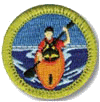 Kayaking
Kayaking
This is a NEW Merit Badge.
The requirements, pamphlet, and badge were released on the official "Earn Date", when Scouts had authorization to begin earning the badge, on June 13, 2012. Note that the first printing of the merit badge pamphlet has a typo in requirement 2. It incorrectly reads "Before doing requirements 3 through 9 ..." instead of "3 through 8".
The requirements are as follows:
- Do the following:
- Explain to your counselor the most likely hazards you may encounter while participating in kayaking activities, including weather and water-related hazards, and what you should do to anticipate, help prevent, mitigate, and respond to these hazards.
- Review prevention, symptoms, and first-aid treatment for the following injuries or illnesses that can occur while kayaking: blisters, cold-water shock and hypothermia, heat-related illnesses, dehydration, sunburn, sprains, and strains.
- Review the BSA Safety Afloat policy. Explain to your counselor how this applies to kayaking activities.
- Before doing requirements 3 through 8, successfully complete the BSA swimmer test: Jump feetfirst into water over the head in depth. Level off and swim 75 yards in a strong manner using one or more of the following strokes: sidestroke, breaststroke, trudgen, or crawl; then swim 25 yards using an easy, resting backstroke. The 100 yards must be completed in one swim without stops and must include at least one sharp turn. After completing the swim, rest by floating.
- Do the following:
- Review the characteristics of life jackets most appropriate for kayaking and why one must always be worn while paddling. Then demonstrate how to select and fit a life jacket for kayaking.
- Review the importance of safety equipment such as a signal device, air flotation bags, extra paddle, sponge, bilge pump, rescue sling, and throw bag.
- Do the following:
- Name and point out the major parts of a kayak.
- Review the differences in the design between recreational, whitewater, and sea or touring kayaks. Include how length, width, stability, and rocker are involved in the design of each type.
- Review the advantages and disadvantages of the materials most commonly used to make kayaks. Explain the care, maintenance, and storage of a kayak.
- Using the trucker’s hitch and bowline, demonstrate how to secure a kayak to a rack on a vehicle or a trailer, or to a rack on land.
- Discuss the following:
- How to choose a kayak paddle
- The different materials from which paddles are made, parts of a paddle, and the care and maintenance of a paddle
- Using a properly equipped kayak with an open cockpit, a sit-on-top, or an inflatable kayak, do the following:
- Safely capsize and perform a wet exit.
- Reenter the kayak with assistance from a buddy boat.
- Demonstrate a kayak-over-kayak rescue.
- Demonstrate the HELP position.
- Capsize the kayak, swim it, and then paddle to shore, and empty water from the kayak with assistance if needed.
- As a solo paddler, use a properly equipped kayak to demonstrate the following:
- Forward stroke
- Backstroke
- Forward sweep
- Reverse sweep
- Draw stroke
- Stern draw
- As a solo paddler, use a properly equipped kayak to demonstrate the following:
- Paddle a straight line for 25 yards, make a sharp turn, and return 25 yards in a straight line.
- Spin or pivot 360 degrees to the right and 360 degrees to the left.
- Move abeam to the right 10 feet and to the left 10 feet.
- Stop the boat in one boat length.
- Paddle a buoyed course of a length determined by your counselor that includes two right and two left turns performed while underway.
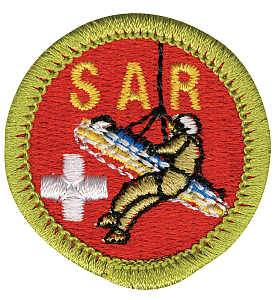 Search
and Rescue
Search
and Rescue
This is a NEW Merit Badge.
The requirements, pamphlet, and badge were released on the official "Earn Date", when Scouts had authorization to begin earning the badge, on August 20, 2012.
The requirements are as follows:
- Do the following:
- Explain to your counselor the hazards you are most likely to encounter while participating in search and rescue (SAR) activities, and what you should do to anticipate, help prevent, mitigate, and respond to these hazards.
- Discuss first aid and prevention for the types of injuries or illnesses that could occur while participating in SAR activities, including: snakebites, dehydration, shock, environmental emergencies such as hypothermia or heatstroke, blisters, and ankle and knee sprains.
- Demonstrate knowledge to stay found and prevent yourself from becoming the subject of a SAR mission.
- How does the buddy system help in staying found and safe?
- How can knowledge of the area and its seasonal weather changes affect your plans?
- Explain how the Ten Essentials are similar to a 'ready pack.'
- Discuss the following with your counselor:
- The difference between search and rescue
- The difference between PLS (place last seen) and LKP (last known point)
- The meaning of these terms:
- AFRCC (Air Force Rescue Coordination Center)
- IAP (Incident Action Plan)
- ICS (Incident Command System)
- Evaluating search urgency
- Establishing confinement
- Scent item
- Area air scent dog
- Briefing and debriefing
- Find out who in your area has authority for search and rescue and what their responsibilities are. Discuss this with your counselor, and explain the official duties of a search and rescue team.
- Complete the training for ICS-100, Introduction to Incident Command System. Print out the certificate of completion and show it to your counselor. Discuss with your counselor how the ICS compares with Scouting’s patrol method.
- Identify four types of search and rescue teams and discuss their use or role with your counselor. Then do the following:
- Interview a member of one of the teams you have identified above, and learn how this team contributes to a search and rescue operation. Discuss what you learned with your counselor.
- Describe the process and safety methods of working around at least two of the specialized SAR teams you identified above.
- Explain the differences between wilderness, urban, and water SARs.
- Discuss the Universal Transverse Mercator (UTM) system, latitude, and longitude. Then do the following: (add map)
- Using a 1:24,000 scale USGS topographic map, show that you can identify a location of your choice using UTM coordinates.
- Using a 1:24,000 scale map, ask your counselor to give you a UTM coordinate on the map, then identify that location.
- Show that you can identify your current location using the UTM coordinates on your Global Positioning System unit and verify it on a 1:24,000 scale map.
- Determine a hypothetical place last seen, and point out an area on your map that could be used for containment using natural or human-made boundaries.
- Choose a hypothetical scenario, either one presented in this merit badge pamphlet or one created by your counselor. Then do the following:
- Complete an incident objectives form for this scenario.
- Complete an Incident Action Plan (IAP) to address this scenario.
- Discuss with your counselor the behavior of a lost person and how that would impact your incident action plan (for example, the differences between searching for a young child versus a teen).
- After completing 8a–8c, discuss the hypothetical scenario with your counselor.
- Discuss with your counselor the terms hasty team and hasty search. Then do the following:
- Plan and carry out a practice hasty search—either urban or wilderness—for your patrol or troop. Include the following elements in the search: clue awareness, evidence preservation, tracking the subject, and locating the subject using attraction or trail sweep.
- When it’s over, hold a team debriefing to discuss the hasty search. Discuss problems encountered, successful and unsuccessful tactics, and ideas for improvement.
- Find out about three career or volunteer opportunities in search and rescue. Pick one and find out the education, training, and experience required for this professional or volunteer position. Discuss this with your counselor, and explain why this position might interest you.
 Archery
Archery
A minor change was made to Requirement 5 OPTION B (f)(2) as shown here:
- Option B - Using a Compound Bow
- Do ONE of the following:
- Shooting 30 arrows in five-arrow ends at an 80-centimeter (32-inch) five-color target at 15 yards and using the 10 scoring regions, make a score of 170 160 .
 Astronomy
Astronomy
Requirement 1 was changed as shown below. According to BSA, this change to requirement 1 is also being made to other merit badges "with an outdoor focus with a greater level of risk. As our pamphlets get updated by our Merit Badge Maintenance Task Force, more will have this new requirement."
Also, the 2011 edition of Boy Scout Requirements
had different text for requirement 9 than the new merit badge pamphlet.
(It showed the text from Requirement 10 of the previous version, but we
showed the newer text.) Since the 2012 edition of Boy Scout Requirements
retained that wording, we show that wording now. The revisions are as follows:
- Do the following:
- Describe the proper clothing and other precautions for safely making observations at night and in cold weather.
Explain to your counselor the most likely hazards you may encounter while participating in astronomy activities, and what you should do to anticipate, help prevent, mitigate, and respond to these hazards.- Tell how to safely observe the Sun, objects near the Sun, and the Moon.
Explain first aid for injuries or illnesses such as heat and cold reactions, dehydration, bites and stings, and damage to your eyes that could occur during observation.- Explain first aid for injuries or illnesses, such as heat and cold reactions, dehydration, bites and stings, and damage to your eyes that could occur during observation.
Describe the proper clothing and other precautions for safely making observations at night and in cold weather. Then explain how to safely observe the Sun, objects near the Sun, and the Moon.- Find out about three different career opportunities in astronomy. Pick one and find out the education, training, and experience required for this profession. Discuss this with your counselor, and explain why this profession might interest you.
List at least three different career opportunities in astronomy. Pick the one in which you are most interested and explain how to prepare for such a career. Discuss with your counselor what courses might be useful for such a career.
 Athletics
Athletics
Requirement 1 was changed as shown below. According to BSA, this change to requirement 1 is also being made to other merit badges "with an outdoor focus with a greater level of risk. As our pamphlets get updated by our Merit Badge Maintenance Task Force, more will have this new requirement."
- Show that you know first aid for injuries or illnesses that could occur while participating in athletic events, including sprains, strains, contusions, abrasions, blisters, dehydration, and heat reactions.
Do the following:
- Explain to your counselor the most likely hazards you may encounter during athletics activities, and what you should do to anticipate, help prevent, mitigate, and respond to these hazards.
- Show that you know first aid for injuries or illnesses that could occur while participating in athletics events, including sprains, strains, contusions, abrasions, blisters, dehydration, and heat reactions.
 Bugling
Bugling
Bugling merit badge was to be discontinued in 2011 and its requirements were to be merged into Music merit badge, but BSA reconsidered that action and decided to retain Bugling as a separate merit badge. A revised merit badge pamphlet which merged Bugling into Music was released in early 2010, but a replacement, retaining both badges was released in 2011 to replace it. The requirements for this merit badge never changed during this period.
In 2012, requirement 2b was revised, as follows:
- Compose a bugle call for your troop or patrol to signal a common group activity, such as assembling for mealtime or striking a campsite. Play the call that you have composed before your unit or patrol..
 Camping
Camping
Requirement 1 was changed as shown below. According to BSA, this change to requirement 1 is also being made to other merit badges "with an outdoor focus with a greater level of risk. As our pamphlets get updated by our Merit Badge Maintenance Task Force, more will have this new requirement."
In addition, requirement 9a was revised,and a mionor change was made to requirement 10. The revised requirements are as follows:
- Show that you know first aid for and how to prevent injuries or illnesses that could occur while camping, including hypothermia, frostbite, heat reactions, dehydration, altitude sickness, insect stings, tick bites, snakebite, blisters, and hyperventilation.
Do the following:
- Explain to your counselor the most likely hazards you may encounter while participating in camping activities and what you should do to anticipate, help prevent, mitigate, and respond to these hazards
- Show that you know first aid for and how to prevent injuries or illnesses that could occur while camping, including hypothermia, frostbite, heat reactions, dehydration, altitude sickness, insect stings, tick bites, snakebite, blisters, and hyperventilation.
- Camp a total of at least 20 days and 20 nights at designated Scouting activities or events. Sleep each night under the sky or in a tent you have pitched. The 20 days and 20 nights must be at a designated Scouting activity or event. You may use a week of long-term camp One long-term camping experience of up to six consecutive nights may be applied toward this requirement. Sleep each night under the sky or in a tent you have pitched. If the camp provides a tent that has already been pitched, you need not pitch your own tent.
- Discuss how the things you did to earn this badge have taught you about personal health and safety, survival, public health, conservation, and good citizenship. In your discussion, tell how Scout spirit and the Scout Oath and Scout Law apply to camping and outdoor ethics.
 Climbing
Climbing
Requirement 1 was changed as shown below. According to BSA, this change to requirement 1 is also being made to other merit badges "with an outdoor focus with a greater level of risk. As our pamphlets get updated by our Merit Badge Maintenance Task Force, more will have this new requirement."
Requirement 3 was also revised. The revisions are as follows:
- Do the following:
- Show that you know first aid for and how to prevent injuries or illnesses that could occur during climbing activities, including heat and cold reactions, dehydration, stopped breathing, sprains, abrasions, fractures, rope burns, blisters, snakebite, and insect bites or stings.
Explain to your counselor the most likely hazards you may encounter while participating in climbing and rappelling activities and what you should do to anticipate, help prevent, mitigate, and respond to these hazards.- Identify the conditions that must exist before performing CPR on a person.
Show that you know first aid for and how to prevent injuries or illnesses that could occur during climbing activities, including heat and cold reactions, dehydration, stopped breathing, sprains, abrasions, fractures, rope burns, blisters, snakebite, and insect bites or stings.- Identify the conditions that must exist before performing CPR on a person.
- Present yourself properly dressed for belaying, climbing, and rappelling (i.e., appropriate clothing, footwear, and a helmet; rappellers and belayers must can also wear gloves).
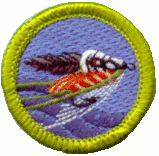 Fly
Fishing
Fly
Fishing
Requirement 1 was changed as shown below. According to BSA, this change to requirement 1 is also being made to other merit badges "with an outdoor focus with a greater level of risk. As our pamphlets get updated by our Merit Badge Maintenance Task Force, more will have this new requirement."
- Do the following:
- Discuss the prevention of and treatment for the following health concerns that could occur while fly-fishing, including cuts, scratches, puncture wounds, insect bites, hypothermia, dehydration, heat exhaustion, heatstroke, and sunburn.
Explain to your counselor the most likely hazards you may encounter while participating in fly-fishing activities and what you should do to anticipate, help prevent, mitigate, and respond to these hazards. Name and explain five safety practices you should always follow while fly-fishing.- Explain how to remove a hook that has lodged in your arm.
Discuss the prevention of and treatment for health concerns that could occur while fly-fishing, including cuts and scratches, puncture wounds, insect bites, hypothermia, dehydration, heat exhaustion, heatstroke, and sunburn.- Name and explain five safety practices you should always follow while fly-fishing.
Explain how to remove a hook that has lodged in your arm.
 Graphic
Arts
Graphic
Arts
Requirement 2 was revised as shown below.
- Explain the differences between continuous tone, line, and halftone artwork. Describe how it digital images can be created and/or stored in a computer.
 Hiking
Hiking
Requirement 1 was changed as shown below. According to BSA, this change to requirement 1 is also being made to other merit badges "with an outdoor focus with a greater level of risk. As our pamphlets get updated by our Merit Badge Maintenance Task Force, more will have this new requirement."
- Show that you know first aid for injuries or illnesses that could occur while hiking, including hypothermia, heatstroke, heat exhaustion, frostbite, dehydration, sunburn, sprained ankle, insect stings, tick bites, snakebite, blisters, hyperventilation, and altitude sickness.
Do the following:
- Explain to your counselor the most likely hazards you may encounter while hiking, and what you should do to anticipate, help prevent, mitigate, and respond to these hazards.
- Show that you know first aid for injuries or illnesses that could occur while hiking, including hypothermia, heatstroke, heat exhaustion, frostbite, dehydration, sunburn, sprained ankle, insect stings, tick bites, snakebite, blisters, hyperventilation, and altitude sickness.
 Motorboating
Motorboating
Requirement 1 was changed as shown below. According to BSA, this change to requirement 1 is also being made to other merit badges "with an outdoor focus with a greater level of risk. As our pamphlets get updated by our Merit Badge Maintenance Task Force, more will have this new requirement."
- Do the following:
- Explain first aid for injuries that could occur while motorboating, including hypothermia, heat reactions, dehydration, motion sickness, insect stings, tick bites, and blisters.
Explain to your counselor the most likely hazards you may encounter while motorboating, and what you should do to anticipate, help prevent, mitigate, and respond to these hazards.- Identify the conditions that must exist before performing CPR on a person, and explain how such conditions are recognized. Demonstrate proper technique for performing CPR using a training device approved by your counselor.
Explain first aid for injuries or illnesses that could occur while motorboating, including hypothermia, heat reactions, dehydration, motion sickness, bugbites, and blisters.- Identify the conditions that must exist before performing CPR on a person, and explain how such conditions are recognized. Demonstrate proper technique for performing CPR using a training device approved by your counselor.
 Music
Music
Changes were made to requirements 3b, 3c, 4b, and 4d. The changes to items 4b, and 4d had previously been made, but then were inadvertently reversed when BSA issued a new merit badge pamphlet and requirements combining the Music and Bugling merit badges.
The revisions are as follows:
- Interview an adult member of your family about music. Find out what the most popular music was when he or she was your age. Find out what his or her favorite music is now, and listen to three of your relative's favorite tunes with him or her. How do those favorites sound to you? Had you ever heard any of them? Play three of your favorite songs for your relative, and explain why you like these songs. Ask what he or she thinks of your favorite music.
- Serve for six months as a member of a school band, choir, or other local organized musical group, or perform as a soloist in public six times.
- Compose and write the score for a piece of music of 12 measures or more, and play this music on an instrument.
- Catalog your own or your family's collection of 12 or more compact discs, tapes, or records, or other recorded music. Show how to handle and store them.
 Personal
Fitness
Personal
Fitness
Changes were made to requirement 8, as shown below.
- Complete the physical fitness program you outlined in requirement 7. Keep a log of your fitness program activity (how long you exercised; how far you ran, swam, or biked; how many exercise repetitions you completed; your exercise heart rate; etc.). Repeat the aerobic fitness, muscular strength, and flexibility tests every two weeks and record your results. After the 12th week, repeat all four the three tests, record your results, and show improvement in each one. For the body composition test, compare Compare and analyze your preprogram and postprogram body composition measurements. Discuss the meaning and benefit of your experience, and describe your long-term plans regarding your personal fitness.
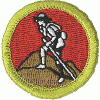 Scouting
Heritage
Scouting
Heritage
Minor changes were made to requirements 2 and 8 and the footnote to requirement 4. The revised requirements are as follows:
- Do the following:
- Give a short biographical sketch summary of any TWO of the following, and tell of their roles in how Scouting developed and grew in the United States prior to 1940.
- Daniel Carter Beard
- William D. Boyce
- Waite Phillips
- Ernest Thompson Seton
- James E. West
- Discuss the significance to Scouting of any TWO of the following:
- Brownsea Island
- The First World Scout Jamboree
- Boy Scout Handbook
- Boys’ Life magazine
- Do ONE of the following:
- Attend either a BSA national jamboree, OR world Scout jamboree, OR a national BSA high-adventure base. While there, keep a journal documenting your day-to-day experiences. Upon your return, report to your counselor what you did, saw, and learned. You may include photos, brochures, and other documents in your report.
- Write or visit the National Scouting Museum in Irving, Texas.* Obtain information about this facility. Give a short report on what you think the role of this museum is in the Scouting program.
*If you visit visited the BSA’s national traveling tour, Adventure Base 100, in 2010, you may use this that experience to fulfill requirement 4b. Visit www.adventurebase100.org (with your parent’s permission) for the schedule and for more information.- Interview at least three people (different from those you interviewed for requirement 5) over the age of 50 40 who were Scouts. Find out about their Scouting experiences. Ask about the impact that Scouting has had on their lives. Share what you learned with your counselor.
 Woodwork
Woodwork
Requirement 1 was changed as shown below. According to BSA, this change to requirement 1 is also being made to other merit badges as pamphlets get updated by the Merit Badge Maintenance Task Force, more will have this new requirement.
In addition, old requirement 6b was deleted, and old requirements 6c and 6d were renumbered as 6b and 6c. Minor changes were also made to requirement 7. The changes are shown below.
- Do the following:
- Show that you know first aid for injuries that could occur while woodworking, including splinters, scratches, cuts, severe bleeding, and shock. Tell what precautions must be taken to help prevent loss of eyesight or hearing, and explain why and when it is necessary to use a dust mask.
Explain to your counselor the most likely hazards you may encounter while participating in woodwork activities, and what you should do to anticipate, help prevent, mitigate, and respond to these hazards. Explain what precautions you should take to safely use your tools.- Earn the Totin' Chip recognition.
Show that you know first aid for injuries that could occur while woodworking, including splinters, scratches, cuts, severe bleeding, and shock. Tell what precautions must be taken to help prevent loss of eyesight or hearing, and explain why and when it is necessary to use a dust mask.- Tell your counselor what precautions you take to safely use your tools.
Earn the Totin’ Chip recognition.- Do any TWO of the following:
- Make working drawings of a project needing - (1) Beveled or rounded edges OR curved or incised cuttings, OR (2) Miter, dowel, or mortise and tenon joints. Build this project.
- Make something for which you have to turn duplicate parts on a lathe.
Make a cabinet, box, or something else with a door or lid fastened with inset hinges.- Make a cabinet, box or something else with a door or lid fastened with inset hinges.
Help make and repair wooden toys for underprivileged children OR help carry out a carpentry service project approved by your counselor for a charitable organization.- Help make and repair wooden toys for underprivileged children; OR help carry out a carpentry service project approved by your counselor for a charitable organization.
- Talk with a cabinetmaker or carpenter. Find out about the training, apprenticeship, career opportunities, work conditions, work hours, pay rates, and union organization for that woodworking experts have in your area.
This analysis was prepared as a service to Scouts and
Scouters nationwide
Paul S. Wolf
Secretary
US Scouting Service Project, Inc.
Printed copies of this document may be freely distributed for use in the Scouting program, so long as the source is acknowledged, but copying the information to another web site is NOT authorized.
A PDF version of this document can be found and downloaded by clicking here.
Page updated on: November 28, 2017







